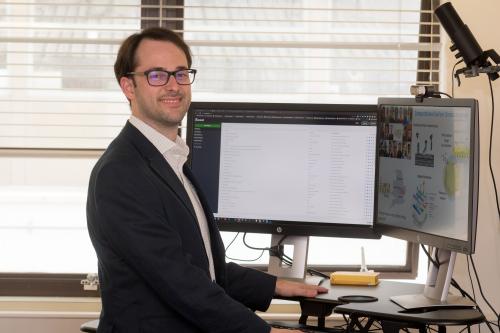Molecular Reactions and Machine Learning


The way ahead is bringing molecular reactions to the surface with machine learning

Professor Reinhard Maurer, Department of Chemistry, Warwick

I work on molecular reactions on surfaces because they present an intriguing scientific challenge. The Austrian theoretical physicist Wolfgang Pauli once said, “God made the bulk; the surface was invented by the devil”. Yet a lot of the chemistry that affects us happens at surfaces, from metal corrosion to catalytic converters in cars.
I was maybe six or seven when I convinced myself that I wanted to become a scientist, not necessarily knowing what that meant. I was inspired by scientists on the TV who seemed so consumed by their passion for something so abstract, so weird. I still love being drawn into the depths of abstract problems. At school and university, I enjoyed Chemistry, Physics and Maths, so computational chemistry is a natural fit for me.
As an undergraduate, I found the theoretical chemistry courses most interesting and realised that everything about quantum mechanics was exciting to me; quantum mechanics is the very reason why atoms are drawn to each other to form molecules.
My research focuses on understanding molecular reactions in catalysis, photochemistry and nanotechnology. I investigate the mechanisms of elementary surface reactions so that we can learn to optimize reaction conditions and exert greater control over surface chemistry, even down to the level of manipulating single molecules.
Typically, in chemistry, we provide energy via heat to initiate reactions and to break and make chemical bonds. Unfortunately, by heating we often activate many different chemical reactions at once. In surface catalysis, we ideally only want to selectively activate one or very few chemical reactions. This is the great challenge of chemical catalysis.
The challenges of our time are connected to chemical reactions with high energy barriers, namely converting nitrogen into ammonia for fertilizer production and converting carbon dioxide into useful chemicals. Both cannot meaningfully be achieved by simply supplying heat. My current research focuses on how we can use light energy in combination with special “plasmonic” metal catalysts to catalyse such challenging reactions. Plasmonic metals (such as for example Copper) can accelerate chemical reactions not only as catalyst, but also because they very efficiently absorb light. This can result in unusual light-driven chemical processes that can more selectively break or make bonds than heat-driven processes could.
The Computational Surface Chemistry group that I lead has recently secured almost €1.5m of grant funding for a project called DeepSpark.
In this project, we seek to use advances in machine learning methodology to dramatically advance our ability to perform computer simulations of chemical reactions at surfaces that involve the coupled dynamics of atoms, electrons, and light. We use machine learning models, to create black boxes that can emulate how quantum mechanical systems will behave without actually having to solve the complicated underlying equations. This will allow us to rapidly simulate many different scenarios to identify the optimal conditions at which we can selectively break and make chemical bonds on surfaces with light.
My hope with DeepSpark is firstly that it will contribute to developing new experiments that reveal interesting new physics and chemistry insights. In the future, my dream is that we can achieve optimal control in catalysis; I want to be able to tell experimental colleagues the exact type of light and reaction conditions they need to create to make one specific reaction happen in a certain way.
As computational chemists, we don’t want to just look at existing experiments, but we want to propose new ones. There’s also potential in industry, because we could identify the most inefficient parts of huge chemical plants and replace them with something that uses light efficiently to make a reaction happen, enabling huge cost and efficiency savings in the process.
What drew me to Warwick was that there is a history of surface science and a clear desire to build a strong focus on computational science. But the best thing is that there are no barriers between disciplines, making it is easy to collaborate with colleagues across departments.
chemistry
